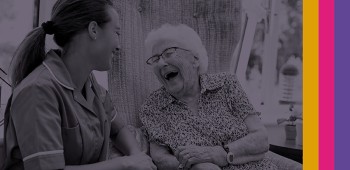 Head of practice development Tracey Gilchrist, practice development nurse Liam Campbell, and practice development facilitator Hayley Shields all are learning disability (LD) nurses working for Enable, a third sector social care provider in Scotland.
Head of practice development Tracey Gilchrist, practice development nurse Liam Campbell, and practice development facilitator Hayley Shields all are learning disability (LD) nurses working for Enable, a third sector social care provider in Scotland.
They have become RCN Nursing Workforce Standards champions, carrying out a successful audit in April 2023 that’s highlighted both what they do well and where they could improve.
Tracey
Initially I was approached by Jonathan Beebee, the RCN’s Professional Lead for LD nursing, as we’re both members of the Scottish LD nurse leads group. I was keen to explore this opportunity to see how the standards and audit could apply to LD nurses working within social care.
Even from the beginning we could see the opportunities the standards could give us. We’re all working in challenging circumstances and sometimes your kneejerk reaction can be, we don’t have the capacity for this, we’re just too busy. I’m so glad we invested some time into it. It’s been a fulfilling process, bringing a good balance against the current demands of our role, while helping to direct the development of our internal governance structures.
We started by using the standards to audit what we do. This has really helped us recognise what we already do well here – sometimes that’s not acknowledged, but it should be. Next we’ve developed action plans where we feel we can make improvements. Some have led to immediate changes, while others are slightly longer term and focused on things we’re working towards.
Both as a team and individually, we’ve felt engaged and well supported in every part of this process, even if it’s exposed something we need to work on. The audit gave us a safe space for reflection, allowing us to move forwards in a planned way, rather than action planning in a crisis or emergency.
Personally, this work has really helped me to recognise the gaps in support I have as a senior learning disability nurse working within social care, holding up a mirror to something I’d felt for a while but hadn’t really addressed. It’s given me clarity and helped me act, guiding me in the right directions towards a more formal structure, involving clinical supervision alongside mentoring with someone I’ve known since I was a nursing student.
Although the standards might be associated with working in a more traditional NHS hospital environment, as learning disability nurses it’s in our nature to adapt what exists already to suit our specific needs. We’ve applied those skills here, interpreting the standards to fit our circumstances.
As a nursing team, this has helped to ground us. It’s been a good journey and will continue to benefit us.
Liam
When we first heard about the standards, I wasn’t at all sure about how they might translate into working in social care. It seemed to me it was more of a hospital-based tool, where you were looking at issues such as staff numbers. I didn’t have a good understanding of how it might work for us. But in practice, it’s really made sense.
Among the tool’s benefits is helping to create structures for some of the conversations we’ve had on specific topics, such as how we assess the risks of lone working. It’s been really useful for promoting these kinds of discussions.
It’s also been instrumental in highlighting the importance of professional development. Our organisation has always been committed to it, but this has put a greater emphasis on setting up regular times, ensuring I take responsibility for making it happen. You feel the benefit because it helps refresh your practice, and undoubtedly that improves the care we’re able to provide for the people we support and their families.
Having these conversations has helped us come together even more as a team. The next audit will highlight how things have changed, as well as setting some new priorities. It will also encourage us to carry on with what we’re already getting right, not letting any of that slip, through complacency.
Hayley
For me, the audit has really pointed out how well supported we are as a team and how there is always someone there to turn to if you need help. There were lots of sections where I was ticking yes, that’s what we’re doing, which felt good. It’s really important to highlight what works well, alongside those areas where you can improve.
During the process we involved a student who was here on placement. We got very honest feedback from her and some great ideas, which we’re taking forwards. This includes a student welcome pack, which I’m involved in creating. We quite often have students, so this is something that will be very helpful for them.
Which standards did the team find particularly helpful?
• Standard 1: executive nurses are responsible for setting nursing workforce establishment and staffing levels. All members of the corporate board of any organisation are accountable for the decisions they make and the action they do or do not take to ensure the safety and effectiveness of service provision.
• Standard 6: a registered nurse lead must receive sufficient dedicated time and resources to undertake activities to ensure the delivery of safe and effective care.
• Standard 7: the time needed for all elements of practice development must be taken into consideration when defining the nursing workforce and calculating the nursing requirements and skill mix within the team.
• Standard 13: the nursing workforce is entitled to work in healthy and safe environments.
• Standard 14: the nursing workforce is supported to practice self-care and given opportunities at work to look after themselves.








